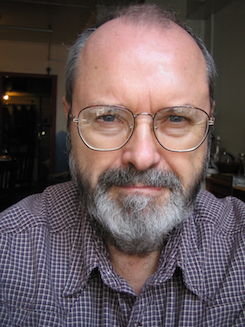Here are Phill Niblock’s releases with the titles linked to the relevent page in the TouchShop. Reviews of all of Phill Niblock’s releases can be read here.
Other Phill Niblock releases may be found at Forced Exposure [USA]
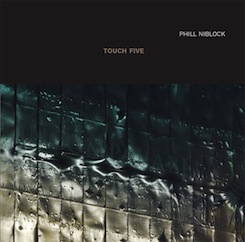
Touch Five
DCD – 5 tracks
CD One
1. FeedCorn Ear (featuring Arne Deforce)
2. A Cage of Stars (featuring Rhodri Davies)
CD Two
1. Two Lips (featuring Zwerg Guitar Quartet)
2. Two Lips (featuring Dither Guitar Quartet)
3. Two Lips (featuring Coh Da Quitar Quartet)
In October 2013 Phill Niblock will be 80…
Phill Niblock writes:
“These CDs include pieces made in two different ways. Traditionally (since 1968), I recorded tones played by an instrument (by an instrumentalist), arranging these single tones into mutli-layered settings, making thick textured drones, with many microtones. In the early days, I prescribed the microtones, tuning the instrumentalist, when I was using audio tape. Later, I used the software ProTools, and made the microtones as I made the pieces. FeedCorn Ear and A Cage of Stars were made this way. In 1998, Petr Kotik asked me to make a piece for orchestra, so, I began to make scores for the musicians to play from. The form of that piece, and the subsequent six scored works, were patterned after a piece in 1992-94, where the musicians were tuned by hearing tones played from a tape through headphones. These are the instructions for the scored piece on the second CD, Two Lips. The score was prepared by Bob Gilmore, from specific directions by me. TWO LIPS, aka Nameless, is conceived as two scores, A and B, to be played simultaneously, lasting 23 minutes. Each score consists of ten instrumental parts. The twenty separate parts should be distributed randomly amongst the musicians of the ensemble; the ‘A group’ and the ‘B group’ are not separated spatially.”
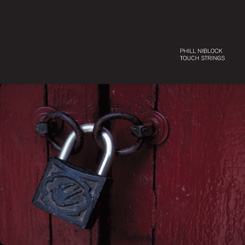
Touch Strings
DCD – 12 tracks
CDOne – 59:03 (6 tracks) 1. – 6. Stosspeng (59 minutes) Susan Stenger and Robert Poss, guitars and bass guitars
CDTwo – 69:28 (6 tracks) 1. Poure (23:30) Arne Deforce, cello 2. – 6. One Large Rose (45:55 minutes) The Nelly Boyd Ensemble, Hamburg – Robert Engelbrecht, cello; Jan Feddersen, piano strummed with nylon strings; Peter Imig, violin; Jens Roehm, acoustic bass guitar strummed with nylon strings or e-bow
Artwork: Jon Wozencroft Photography: Phill Niblock
This is Phill Niblock’s 4th release on Touch, after Touch Works… [TO:49, 2000], Touch Food [TO:59, 2003] and Touch Three [TO:69, 2006].
“Stosspeng was completed in April 2007; Poure in September 2008 and One Large Rose in May 2008. The Stosspeng recording session to obtain the materials for the piece was on December 20 2006 at Robert Poss’s Trace Elements studio on E 4th Street and Ave A, in New York. Robert was the engineer. The piece was completed using Protools in April 2007, in Vienna, Austria. It was premiered at the Donau Festival in Krems Austria on April 30 2007.
The material for Poure was recorded in Johan Vandermaelen’s Amplus studio in Aaigem Belgium, with technical assistance by Guy De Bievre. Much of the construction of the piece, in Protools, was done in a residency at Atelier Azur in Hoenefoss, Norway at the Hval Station, in mid August 2008. It was finished in Ellen Fullman’s studio in Berkeley California on September 7. It was premiered at Kasteel Schuurlo, Sint-Maria-Aalter, Belgium on September 12 2008 and it was commissioned by the Centre de Recherches et de Formation Musicales de Wallonie, CRFMW, Liege, Belgium.
One Large Rose was made with the musicians playing from a score, and recorded acoustically and in real time. There are four recordings of 46 minutes each, superimposed. Recorded by Jens Roehm at Christianskirche, Hamburg, Germany, recording assistance by Julia Berg, on May 15 and 16 2008. Mixing was done by Jens Roehm and the ensemble in Hamburg, and the final mix was done in New York at Experimental Intermedia on October 13 2008.
The mastering for CD, of all pieces, was done by Tom Hamilton, in New York.” Phill Niblock, August 2009
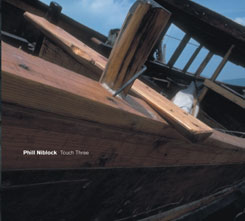
Touch Three
[Touch # TO:69, 2006]
3CD – 9 tracks
These nine pieces were made from March 2003 to January 2005. They were all made (except “Sax Mix”) by recording a single instrument with a single microphone. The recordings were direct to the computer/hard disk, most of them using my Powerbook G4, Protools, an M-box and an external firewire drive. The resulting mono sound files were edited to remove breathing spaces, leaving the natural decay of the tone, and the attack of the subsequent iteration of the same tone. Each note was represented by several repetitions, perhaps ten for each tone, of about 15 seconds duration each. Each piece uses a few tones. A simple chord, perhaps. Additional microtonal intervals were produced in Protools using pitch shift. The pieces were assembled in multitracks, usually either 24 or 32 tracks. The recording environment varied from a simple apartment in Berlin (Ulrich Krieger’s) to a very large hall used for symphony orchestra performances and recordings, with a sizable audience space (Deutschland Radio, Cologne). The recordings were generally done quite closely miked.
One hears only the sound of the instrument. There is no electronic manipulation in the recording, the editing of the tones, or in the mix. The only changes to the recorded tones are the pitch shifts to create microtones. The microtones are doing the work.
“Harm” (24:43, March 18, 2003) Arne Deforce, cello . The recording of the tones was done by Johan Vandermaelen (Amplus) in the Orpheus Institute in Gent, Belgium, direct to the hard drive. The piece was finished in Berlin and premiered at Maerz Musik Festival (the day after finishing). It was commissioned by Maerz Musik.
“Sethwork” (21:48, 2003) Seth Josel, acoustic, unamplified guitars played with e-bow, June 21 2003
“Lucid Sea” (20:24, August 8, 2003) Lucia Mense, recorders
These two pieces were commisioned by Deutschland Radio in Cologne, Germany. Frank Kaempfer, producer; Michael Peschko, recording engineer for the recording of the guitar samples and the recorder samples at the Deutschlandradio Studios in Cologne.
The piece was constructed in the Experimental Intermedia studios in New York (Sethwork) and in Gent (Lucid Sea), in Protools. The broadcast was on Saturday October 4, 2003 at 2205 on Deutschland Radio in Cologne, “ATELIER NEUER MUSIK”. There was a commentary and an interview by the critic and author Egbert Hiller.
It was for the 70th birthday of Phill Niblock, which was October 2.
“Parker’s Altered Mood, aka, Owed to Bird” (16:27, 2004) Ulrich Krieger, alto saxophone. The tones for this piece and for “Alto Tune” were recorded in Berlin in Ulrich Krieger’s apartment (very nice sound; high, peaked ceiling) with Thomas Ankersmit recording, using his Neumann microphone, direct to HD through Mac Powerbook/Protools/Mbox. For ‘Mood”, I asked Ulrich to pick a Parker tune for the theme. We decided on “Mood”, a slow blues, a thirteen note theme. We recorded Ulrich playing each note for about 15 seconds, the thirteen notes in succession, and for six repetitions of the theme. Ulrich did not listen to the previous takes, so the notes are slightly out of tune with each other, creating the microtones I would have made in Protools. The piece starts with all six playings of the theme, superimposed.
“Zrost” (23:32, 2004) Martin Zrost, soprano saxophone. Martin had just bought a new soprano, which sounded great, so we recorded in his work room in Vienna.
“Not Yet Titled” (22:20, 2003) Franz Hautzinger, trumpet. The tones were recorded in Volker Straebel’s apartment in Steglitz, Berlin, on a summer afternoon, with the balcony door open, the sounds of birds and planes coming through. Melvyn Poore was the engineer, using Franz’s Neumann microphone, mostly in the bell of the trumpet. Franz produced the low bass sounds with the horn. We premiered the piece in a Musikprotokoll concert in the Steirischen Herbst Festival, Graz, Austria. It was commissioned by them as well.
“Valence” (2005, 23:02) Julia Eckhardt, viola. “Valence” was commissioned by the Q O2 Ensemble, Brussels, and the tones were recorded by Johan Vandermaelen in his studio in the Belgian countryside.
“Alto Tune” (25:08, 2004) Ulrich Krieger, alto saxophone. Recording info noted above.
“Sax Mix” (25:08, 2004) Ulrich Krieger, alto, tenor and baritone saxophones.
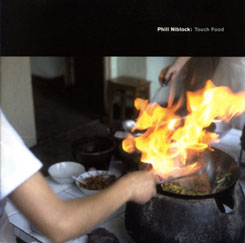
Touch Food
[Touch # TO:59, 2006]
2CD – 4 tracks
This CD was one of the albums of the year in The Wire (UK), 2003
Phill says “The pieces on this CD were made for and with the musicians Reinhold Friedl (piano), Ulrich Krieger (baritone saxophone), Carol Robinson (clarinets) and Kasper T. Toeplitz (electric bass). We recorded the instrument samples at CCMIX in Paris in April 2001. Two of the pieces were completed by the end of the residency of one month, and we recorded some passes of the musicians playing with the multitrack (in Protools) recording. Those were the clarinet and electric bass pieces. I made a few versions of the piano piece at CCMIX, and a test for the saxophone piece. That piece was completed in my studio in New York in March 2002, using 24 tracks in Protools. I had created an awkward situation, four pieces of 25 minutes, but a CD would only hold three. So I decided to make a 75 minute version of the piano piece. I became a little tired at 70 minutes, and since I am 70 this year, I stopped at that. I changed the structure of that piece every 15 minutes, so we have made a new program number at each 15 minutes.”
From Gerard Pape, of CCMIX, Paris:
Phill Niblock: Timbre as Space in Suspended Time
In the music of Phill Niblock, we are confronted with the aural equivalent of trompe-l’oeil. Apparently static clouds of harmonically dense material turn out to be not so static as they appear. What’s more, one has the distinct impression that the music is changing spatially over time . How is all of this possible ? The key is in Niblock’s use of time. In his music, the experience of time is as very slow and continuous. There are no disruptive, discontinuous musical events to disrupt the flow of time. Time is suspended. Niblock’s music gives the impression of having always been and continuing to be. Yet, this is not the idea of Being as stasis. Each time one feels tha Niblock’s music isn’t changing, one realizes that it is never the same, an yet, always the same.
Being and Becoming as one. Moving Immobility.
This is a music that breathes slowly and deeply. It changes its spatial form slowly, as a person who is in deep meditation changes the form of his body ever so slowly as he peacefully expands and contracts the walls of his chest cavity with each new cycle of inspiration/expiration.
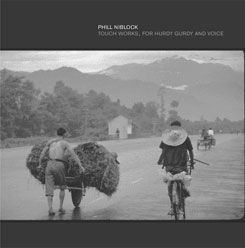
Touch Works, For Hurdy Gurdy and Voice
[Touch # TO:49, 2000]
CD – 3 tracks
This is the first CD by Phill Niblock for Touch. Thomas Buckner, baritone voice (samples and live) All were completed with Protools software in a Macintosh computer, and are 24 tracks mixed to stereo. There are two versions of the voice piece, one the original tape piece, the other a version with three added voices, live, plus four tracks of pitch shift on each, done in Robert Poss’s (Trace Elements) studio. Samples and live elements were recorded by Robert Poss at Trace Elements Studios in New York. The pieces were constructed and mixed in ProTools by Phill Niblock at Experimental Intermedia in New York. [AYU was commissioned by Thomas Buckner]







